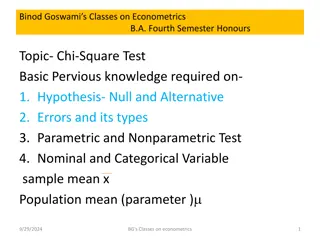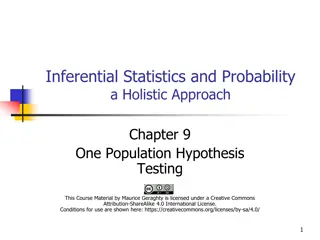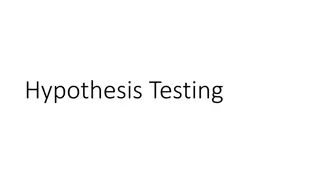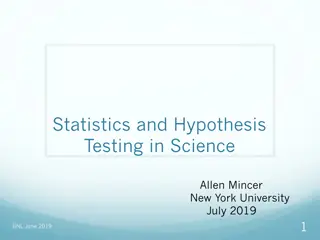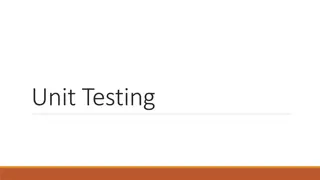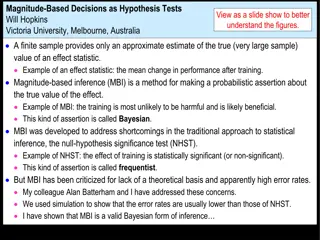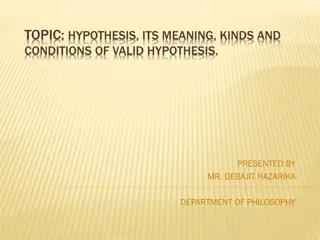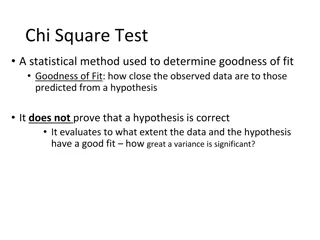Hypothesis Testing Examples and Scenarios
Explore various scenarios involving hypothesis testing, including coin bias, dice rolling, and election candidate support estimation. Learn to define test statistics, null and alternative hypotheses, select significance levels, and determine conditions for rejecting the null hypothesis based on sample data.
Download Presentation

Please find below an Image/Link to download the presentation.
The content on the website is provided AS IS for your information and personal use only. It may not be sold, licensed, or shared on other websites without obtaining consent from the author. Download presentation by click this link. If you encounter any issues during the download, it is possible that the publisher has removed the file from their server.
E N D
Presentation Transcript
Your turn Worked example John believes a coin is biased in favour of landing with tails uppermost. He tosses the coin 8 times and counts the number of times, ?, it lands with tails uppermost. Define the test statistic and state your null and alternative hypotheses. Joan believes a six-sided dice is biased in favour of rolling a 4. She rolls the dice 10 times and counts the number of times, ?, it rolls a 4. Define the test statistic and state your null and alternative hypotheses. ? = number of tosses that land on tails ? = probability/proportion of tosses that land on tails ?0:? = 0.5 ?1:? > 0.5
Your turn Worked example An election candidate believes she has the support of 40% of the residents in a particular town. A researcher wants to test, at the 5% significance level, whether the candidate is over-estimating her support. The researcher asks 20 people whether they support the candidate or not. 3 people say they do. a) Write down a suitable test statistic. b) Write down two suitable hypotheses. c) Explain the condition under which the null hypothesis would be rejected. An election candidate believes he has the support of 30% of the residents in a particular town. A researcher wants to test, at the 10% significance level, whether the candidate is over-estimating his support. The researcher asks 30 people whether they support the candidate or not. 2 people say they do. a) Write down a suitable test statistic. b) Write down two suitable hypotheses. c) Explain the condition under which the null hypothesis would be rejected. a) ? = number of people who say they support the candidate b) ? = probability/proportion of people that support the candidate ?0:? = 0.4 ?1:? < 0.4 c) Reject ?0 if ? ? 3 < 0.05
Your turn Worked example An election candidate believes she has the support of 40% of the residents in a particular town. A researcher wants to test, at the 2% significance level, whether the candidate is under-estimating her support. The researcher asks 20 people whether they support the candidate or not. 12 people say they do. a) Write down a suitable test statistic. b) Write down two suitable hypotheses. c) Explain the condition under which the null hypothesis would be rejected. An election candidate believes he has the support of 30% of the residents in a particular town. A researcher wants to test, at the 1% significance level, whether the candidate is under-estimating his support. The researcher asks 30 people whether they support the candidate or not. 11 people say they do. a) Write down a suitable test statistic. b) Write down two suitable hypotheses. c) Explain the condition under which the null hypothesis would be rejected. a) ? = number of people who say they support the candidate b) ? = probability/proportion of people that support the candidate ?0:? = 0.4 ?1:? > 0.4 c) Reject ?0 if ? ? 12 < 0.05
Your turn Worked example In a manufacturing process, the proportion of faulty bolts is, based on historical data, 0.07. A sample of 100 bolts is tested, and 4 are found to be faulty. The manager wishes to test at the 1% significance level whether or not there has been a reduction in the proportion of faulty bolts. a) Write down a suitable test statistic. b) Write down two suitable hypotheses. c) Explain the condition under which the null hypothesis would be rejected. In a manufacturing process, the proportion of faulty lightbulbs is, based on historical data, 0.08. A sample of 200 lightbulbs is tested, and 11 are found to be faulty. The manager wishes to test at the 2% significance level whether or not there has been a reduction in the proportion of faulty lightbulbs. a) Write down a suitable test statistic. b) Write down two suitable hypotheses. c) Explain the condition under which the null hypothesis would be rejected. a) ? = number of faulty bolts b) ? = probability/proportion of faulty bolts ?0:? = 0.07 ?1:? < 0.07 c) Reject ?0 if ? ? 4 < 0.01
Your turn Worked example Joan believes the probability of rolling a 4 on a six- sided dice is 1 6. She rolls the dice 10 times and counts the number of times, ?, it rolls a 4. Define the test statistic and state your null and alternative hypotheses. John believes a coin is lands on tails with probability 1 2. He tosses the coin 8 times and counts the number of times, ?, it lands with tails uppermost. Define the test statistic and state your null and alternative hypotheses. ? = number of tosses that land on tails ? = probability/proportion of tosses that land on tails ?0:? = 0.5 ?1:? 0.5
Your turn Worked example An election candidate believes she has the support of 40% of the residents in a particular town. A researcher wants to test, at the 5% significance level, whether this claim is true. The researcher asks 20 people whether they support the candidate or not. 3 people say they do. a) Write down a suitable test statistic. b) Write down two suitable hypotheses. c) Explain the condition under which the null hypothesis would be rejected. An election candidate believes he has the support of 30% of the residents in a particular town. A researcher wants to test, at the 10% significance level, whether this claim is true. The researcher asks 30 people whether they support the candidate or not. 2 people say they do. a) Write down a suitable test statistic. b) Write down two suitable hypotheses. c) Explain the condition under which the null hypothesis would be rejected. a) ? = number of people who say they support the candidate b) ? = probability/proportion of people that support the candidate ?0:? = 0.4 ?1:? 0.4 c) Reject ?0 if ? ? 3 < 0.025
Your turn Worked example An election candidate believes she has the support of 40% of the residents in a particular town. A researcher wants to test, at the 2% significance level, whether this claim is true. The researcher asks 20 people whether they support the candidate or not. 12 people say they do. a) Write down a suitable test statistic. b) Write down two suitable hypotheses. c) Explain the condition under which the null hypothesis would be rejected. An election candidate believes he has the support of 30% of the residents in a particular town. A researcher wants to test, at the 1% significance level, whether this claim is true. The researcher asks 30 people whether they support the candidate or not. 11 people say they do. a) Write down a suitable test statistic. b) Write down two suitable hypotheses. c) Explain the condition under which the null hypothesis would be rejected. a) ? = number of people who say they support the candidate b) ? = probability/proportion of people that support the candidate ?0:? = 0.4 ?1:? 0.4 c) Reject ?0 if ? ? 12 < 0.01
Your turn Worked example In a manufacturing process, the proportion of faulty bolts is, based on historical data, 0.07. The manufacturing process is changed. A sample of 100 bolts is tested, and 4 are found to be faulty. The manager wishes to test at the 1% significance level whether or not there has been a change in the proportion of faulty bolts. a) Write down a suitable test statistic. b) Write down two suitable hypotheses. c) Explain the condition under which the null hypothesis would be rejected. a) ? = number of faulty bolts In a manufacturing process, the proportion of faulty lightbulbs is, based on historical data, 0.08. The manufacturing process is changed. A sample of 200 lightbulbs is tested, and 11 are found to be faulty. The manager wishes to test at the 2% significance level whether or not there has been a change in the proportion of faulty lightbulbs. a) Write down a suitable test statistic. b) Write down two suitable hypotheses. c) Explain the condition under which the null hypothesis would be rejected. b) ? = probability/proportion of faulty bolts ?0:? = 0.07 ?1:? 0.07 c) Reject ?0 if ? ? 4 < 0.005


